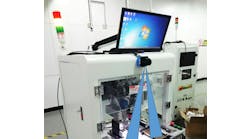Mike Bacidore is the editor in chief for Control Design magazine. He is an award-winning columnist, earning a Gold Regional Award and a Silver National Award from the American Society of Business Publication Editors. Email him at [email protected].
As robot integration continues to rise and converge with the Industrial Internet of Things (IIoT), it’s meant a resounding explosion in growth for sensing devices and vision systems.
Measurements and information are invaluable, but you can’t measure what you can’t see or sense. North American sales of machine vision systems and components grew nearly 25% in the first three months of 2015. This was its biggest quarter in history, according to trade group AIA. Smart cameras and application-specific machine vision (ASMV) systems are part of those machine vision systems. In the first quarter, smart cameras grew by 23%, while ASMV systems were up 24%.
Even machine vision components were strong with more than 10% growth over the first quarter of the previous year. The leading product categories within machine vision components in terms of growth were lighting (28%), cameras (11%) and software (8%).
“Industry experts remain bullish on machine vision components for the next two quarters—less so for machine vision systems however, where 55% of survey respondents believe the category will be flat, 25% expect an increase and 20% expect a decline,” says Alex Shikany, AIA’s director of market analysis.
Also read: The rise of robots and the enabling sensing technology
U.S. sensor sales should climb at more than 6% through the end of next year, peaking at $14.9 billion, according to a recent report from Freedonia Group. Process variable sensors will remain the largest category, while chemical property sensors and proximity and positioning sensors will post the fastest growth. The Freedonia study analyzed the $11.1 billion U.S. sensors industry, presenting historical demand data for 2001, 2006 and 2011 and forecasting sales for 2016 and 2021 by sensor type. The robotic renaissance has given us a renewed need for increased sensing technology and improved vision. Connectivity and collaboration have upped the ante to the point where a sensorless system might soon be considered a simple machine, comparable to a pulley or a wedge.
Robots soon will be as ubiquitous as the IIoT aspires to be. Vision systems and sensors play a major role in the rise of each. Collaborative robots will allows humans to work with them, side by side, and connectivity will bring machines together, but none of this can occur without sensing technologies. The connected enterprise will include equipment, robots and humans. Everywhere. All the time.
Sensors are becoming better, smaller, less expensive and embedded. From new technologies, such as LIDAR and leap-motion sensing, to established ones such as safety-rated sensors, all products are finding an equally impressive growth curve. Machines and integrated robots are benefitting from mobile applications enabled by smart devices, as well. Industrial connectivity that includes sensor data can enable remote control and monitoring of equipment via access to big data and analytics over a network.
The future is here.




